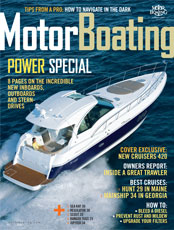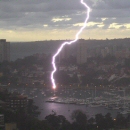Articles
Article in July 2010 PassageMaker
Peter Swanson's article "Rewriting the Book on Lightning Protection" in the July/August 2010 issue of PassageMaker is an excellent discussion of the concepts and history behind our system. It also talks about the current state of the ABYC and NFPA standards in this area.
An abbreviated account is
available here.
MotorBoating May 2009
Vincent Daniello suggests that you can "Lightning-Proof Your Boat", but not using just bonding and a ground plate as has generally been accepted.
After discussing the damage to a friend's properly bonded and grounded 60' fisherman, he concludes that
the problem was with the "exit ramp". Lightning exit points through the engine, bow thruster and shore power connection resulted in disturbing outcomes such as "The bow thruster was activated and was stuck running hard to port.
" He then takes the reader on a comprehensive guided tour through
the components and installation of a system
based on external conductors and grounding. You can download a pdf file for the full article here.
Boat US Exchange October 2007
"Protect a Boat Like a Building" is Ewen Thomson's mantra in this discussion of the new methods described in the latest edition of the lightning protection standard for watercraft published by the National Fire Protection Association - Chapter 10 in NFPA780-2011.
In a building the convention for many decades has been to place the lightning conductors - rods on the roof, down conductors, and ground rods - on the outside. Older marine standards have tended to favor a single rod, down conductor, and ground plate right through the middle of the boat.
Not surprisingly to ground-based lightning system engineers this technique
tends to promote sideflashes through the hull and extensive electronics damage. Thomson's article walks us through the observations, concepts and
implementation in a marine system.
Panbo October 2006
This on-line article by Ben Ellison is one of the earliest to describe our first system on the passagemaker John Henry.
This was a follow-on from his 2003 article which was a general description of the subject.
 Professional BoatBulder April/May 2004 Professional BoatBulder April/May 2004
In December/January 2004 Professional BoatBuilder pp. 26-42, Nigel Calder reviewed the state of lightning protection at that time. This letter written by Ewen Thomson as a follow-up to Nigel's article is a discussion of the concept of dynamic grounding, its association with the edges of a ground plate or strip, and its role in the development of the SiedarcTM electrode. Included are photographs showing dentritic spark tracks left behind as current flowed from the lead keel and fiberglass rudder.
 Sea Grant pamphlet & video July 1992 Sea Grant pamphlet & video July 1992
"Lightning & Sailboats" (SGEB-17) is the layman's version of Ewen's 1991 IEEE article. The 23-minute "Lightning and Sailboats" video accompanying this pamphlet is available for $15 from IFAS.
See the comments on the IEEE paper below for qualifications regarding some of the concepts presented in both of these.
IEEE Trans EMC May 1991
After analyzing both existing standards and the underlying science, Dr. Ewen Thomson wrote "A Critical Assessment of the U.S. Code for Lightning Protection of Boats" when he was an Associate Professor and lightning researcher in the Department of Electrical Engineering at the University of Florida. This peer-reviewed paper uses actual damage data provided by the owners of sailboats struck by lightning to further the science and gain insights into factors such as water salinity and conductor size. This was ten years before he invented the Siedarc TM electrode so that the theory applied does not reflect our present understanding of the importance of charge accumulation both on the boat and on the water surface. Specifically voltages were assumed to form as a result only of current flow in the water whereas in many cases the damage caused by sideflashes is consistent with sparks that precede, and sometimes supercede, any current flow from immersed ground plates and keels. |

